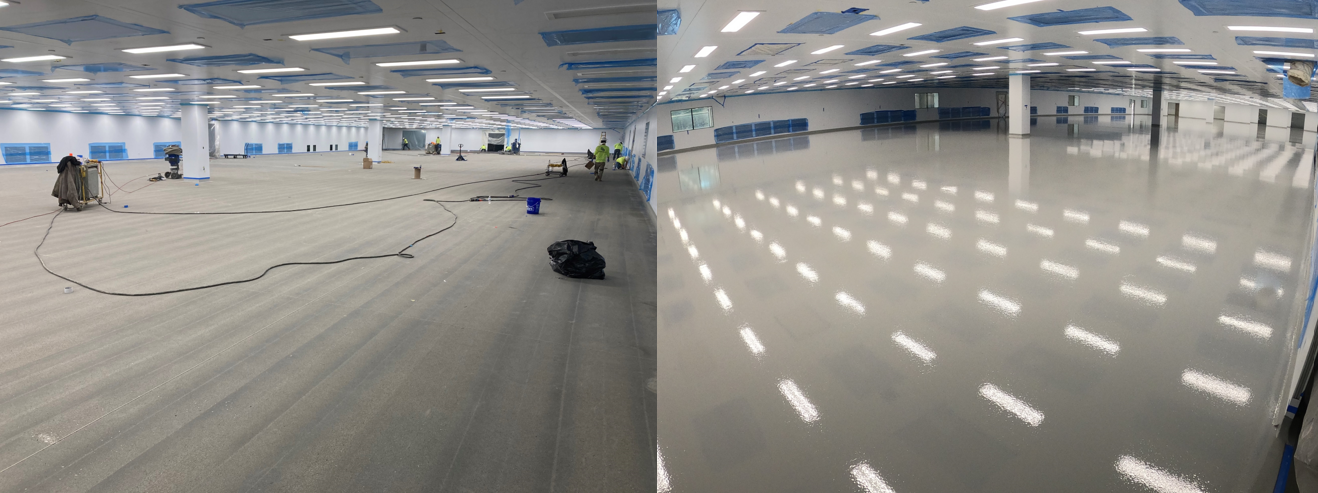
Durable Surfaces’ crews met the client’s requirements for a high-performance medical manufacturing coating on an accelerated production schedule.
Durable Surfaces | Dec 14, 2021
Transforming a concrete floor once designed for normal warehouse operations into a clean room production area requires the coordination of a skilled coatings installer, a high quality resin manufacturer, a clean room expert, and an engaged general contractor. Fortunately for the medical device manufacturer, the team at Durable Surfaces were ready to deliver a highly resilient floor. Durable Surfaces (DS), LLC is a contractor whose focus is the repair, restoration, and protection of concrete surfaces. Headquartered in Malvern, PA, Durable Surface crews have treated millions of square feet throughout the United States.
Durable Surfaces was hired by the general contractor on behalf of a medical device manufacturing company to upgrade an existing building for increased production capacity. The project was to install a high-performance coating system for clean rooms, air locks, and production areas that will eventually upgrade a total 50,200 sf of floor area, along with installing 3,000 linear feet of seamless cove. The project was split into two-phases. Phase 1 was 33,500sf, along with 2,000lf of 4.5” seamless cove base with a 2.5” radius. Phase 2 is the remaining 17,000 sf.
Preparing the Floor
With a tight timeline for Phase 1 and the overall construction schedule quickly approaching its turnover date, there was no margin for error. According to Jeff Desso, Durable Surfaces' Project Manager – “Everyone in this industry knows that without good surface preparation, the best coating systems will fail.” DS coating technicians began their work on the day of their arrival and began with a thorough inspection of the floor. The inspection also included testing the floor for relative humidity with Wagner L6 probes installed 2 weeks earlier. Along with high humidity levels within the concrete, DS concrete inspections outlined areas of delamination and joint spalling that would need repair. Durable Surface superintendents worked with the client to develop a repair and installation plan that minimized construction time yet leaving a durable surface that would allow for a secure primer bond.
Work began shot blasting Phase 1 using Blastrac shot blasters and Hilti hand tooling for edge work to achieve the correct CSP. The crews repaired all the cracks, spalls, and delamination with an epoxy mortar. The existing AES wall system utilized an aluminum channel which was primed with a tack material that improves the bond between the aluminum wall channel and the cove materials. After installing the cove base per construction detail, the crews primed the entire floor area with a moisture vapor primer (MVP) from ProRez Coatings, LLC to mitigate any chance of coating delamination.
Safeguarding the Future
Following the MVP, coating installation began by treating and covering all repair areas. The repair areas included control and construction joints with 12” fiberglass chop strand mat, saturated in flexible epoxy. Steve Hyde, the Superintendent on the project, expressed that “The treatment is designed to mitigate crack transfer from the slab’s control joints to the new coating.” The crew provided an additional level of protection against any joint movement and potential cracking by installing a 40-mil coat of ProRez Flexible Epoxy.
The main treatment was a 3/16” coating of ProRez Self-Leveling epoxy. The treatment resulted in the proper floor thickness and resilience, that matched and exceeded the original flooring specification.
Following the SL install DS crews coated the cove base with pigmented cove resin to seal the cove matrix.
Durable and Safe
Durable Surfaces worked closely with the General Contractor to understand the clients’ expectations for their clean rooms. We had to account for not only providing an aesthetically pleasing coating, but one that was designed to be durable and safe.
Safety was the focus of the client, safety for the workers and safety for the manufacturing process. The client had a special requirement for the floor’s topcoat with respect to anti-slipping. Workers are required to wear protective fabric booties in these areas. Normal anti-skid aggregate could not be used, as the risk of fabric shedding caused a quality control issue for the client. During the design phase we landed on providing an orange peel texture finish with enough dimpling on pigmented epoxy’s surface to break the surface tension, while providing them the slip resistance they requested.
Durability of the system was a key requirement. A major cause for concern during the design phase, was their existing systems tended to crack along joint lines and transfer through the coating. If the coating ever failed and cracks transferred through the system, it would generate a shutdown of that room. Any shut down would cost a staggering financial loss per day. Durable Surfaces accepted the challenge for a quick install of a technical floor, designed to address everyone’s concerns.